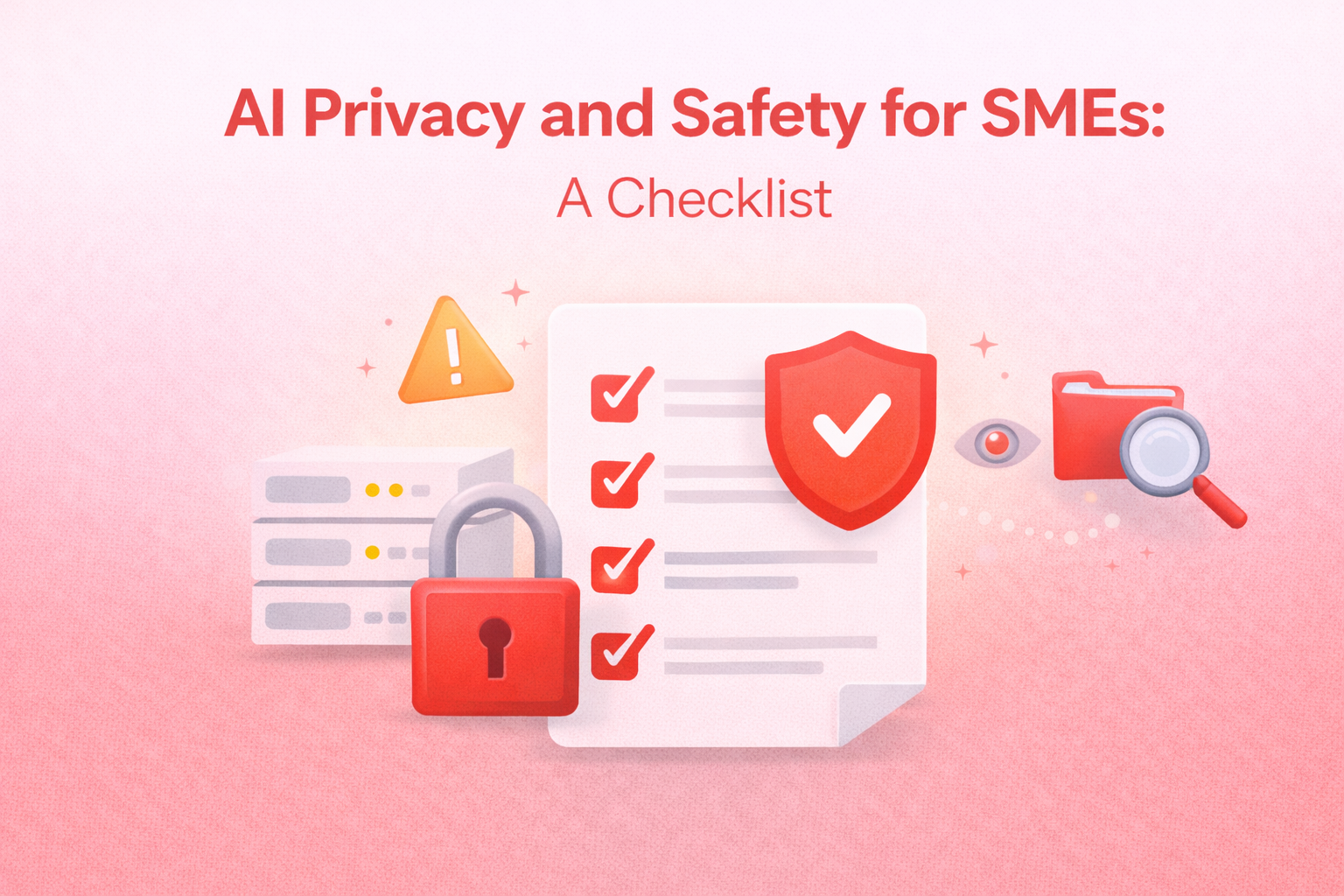SMEs can gain the benefits of AI without courting risk by installing a lightweight governance layer that controls data, tools, people, and vendors; the checklist below prioritizes quick wins first, then deeper controls that scale with growth.
Map usage and risks
- Inventory every AI tool in use (including “shadow AI”), the data it touches, and the business process it affects; classify each use case as low, medium, or high risk based on sensitivity and impact.
- Document data flows for each use (inputs, prompts, outputs, storage, logs), noting any personal data, regulated data, or client-confidential information.
Set policy and guardrails
- Publish a 1–2 page AI Acceptable Use Policy: approved tools, prohibited uses (e.g., legal/medical advice, decisions about individuals), restricted data classes, review requirements, and escalation paths.
- Define a “safe vs restricted data” matrix for prompts; prohibit entering secrets, credentials, PCI, PHI, or client-confidential data into public models without written approval.
Configure secure defaults
- Turn on enterprise controls where available: data-processing addenda, data-use restrictions (no training on customer content), region pinning, retention limits, audit logging, and SSO/SAML.
- Enforce least-privilege access to data sources that copilots can reach; remember assistants surface what users can access, not what they should access.
Handle personal data lawfully
- Identify lawful bases for any personal-data processing in AI workflows; minimize collection, pseudonymize where possible, and respect data-subject rights.
- Run a lightweight DPIA for moderate/high-risk AI use cases; record risks, mitigations, and approvals.
Procurement and vendor diligence
- Require AI vendors to provide a security and privacy summary: data flows, training use of customer data, sub-processors, retention, encryption, model/endpoint locations, and incident response.
- Add contract controls: DPA, breach notice, no training on your content by default, model/region transparency, and clear liability caps aligned to risk.
Human review and quality control
- Institute “human-in-the-loop” review for external content, decisions that affect people, and anything compliance-sensitive; create checklists for fact-checking and citations.
- Watermark or label AI-assisted content internally; maintain version history and who approved what.
Model and prompt hygiene
- Centralize approved prompts for repeat tasks; remove customer identifiers and secrets; prefer retrieval over pasting source data.
- Log prompts and outputs for key workflows; sample for accuracy, bias, and leakage each month.
Security integration
- Add AI to existing security policies: password managers, MDM on endpoints, DLP rules blocking uploads of restricted file types, and egress monitoring for prompt-paste patterns.
- Train staff to recognize prompt-injection, data-exfiltration attempts, and malicious file outputs.
Bias, fairness, and safety checks
- For any AI output that impacts people (hiring, lending, support prioritization), define measurable fairness criteria and test on representative samples; keep test records.
- Provide a clear path for users and staff to report harmful or biased outcomes; triage and fix quickly.
Transparency to customers
- Update your privacy policy to explain AI use, categories of data processed, retention, and user choices; link to an “AI Use” page that lists high-impact applications in plain language.
- Offer contact routes for questions, opt-outs where feasible, and a service-level for human review on request.
Training and culture
- Onboard every new hire with a 30-minute AI safety briefing: what not to paste, approved tools, and review standards; refresh quarterly with new risks and examples.
- Reward teams for safe automation ideas; make it easy to request new AI tools through a simple intake form.
Record-keeping and audit
- Maintain a single register of AI use cases, risk ratings, approvals, vendors, DPAs, and DPIAs; review quarterly.
- Tag projects that may fall under higher-risk categories (hiring, credit, health) and pre-plan extra controls.
Incident readiness
- Extend your incident response plan to cover AI: hallucinated defamation, data leaks via prompts, unsafe code suggestions, and harmful customer interactions; run a tabletop twice per year.
- Prepare takedown/rollback procedures and messaging templates for rapid correction.
Roadmap for SMEs (90 days)
- Weeks 1–2: Inventory tools and data; ship the 2-page AI policy; enforce SSO and basic vendor DPAs.
- Weeks 3–4: Stand up prompt and output review for external content; deploy DLP rules; publish “AI Use” and privacy updates.
- Weeks 5–8: Run DPIAs on high-risk cases; centralize approved prompts; add audit logging and retention limits.
- Weeks 9–12: Bias/fairness tests for people-impacting use; tabletop incident drill; quarterly register review.
Minimal templates to copy
Policy outline
- Purpose and scope
- Approved tools and prohibited uses
- Data classification and handling rules
- Review and approval thresholds
- Incident reporting and escalation
DPIA one-pager
- Use case and purpose
- Data categories and sources
- Risks (privacy, bias, security) and impact rating
- Mitigations and residual risk
- Owner, approver, review date
Vendor questionnaire (short)
- Data used for training? Default off toggles?
- Storage/retention controls and regions
- Sub-processors and certifications
- Encryption in transit/at rest; key ownership
- Logging/audit access and deletion paths
Adopt the above as “small but strong” controls: brief policies, concrete defaults, and monthly hygiene checks will cover most SME risk while preserving the speed that makes AI valuable.


